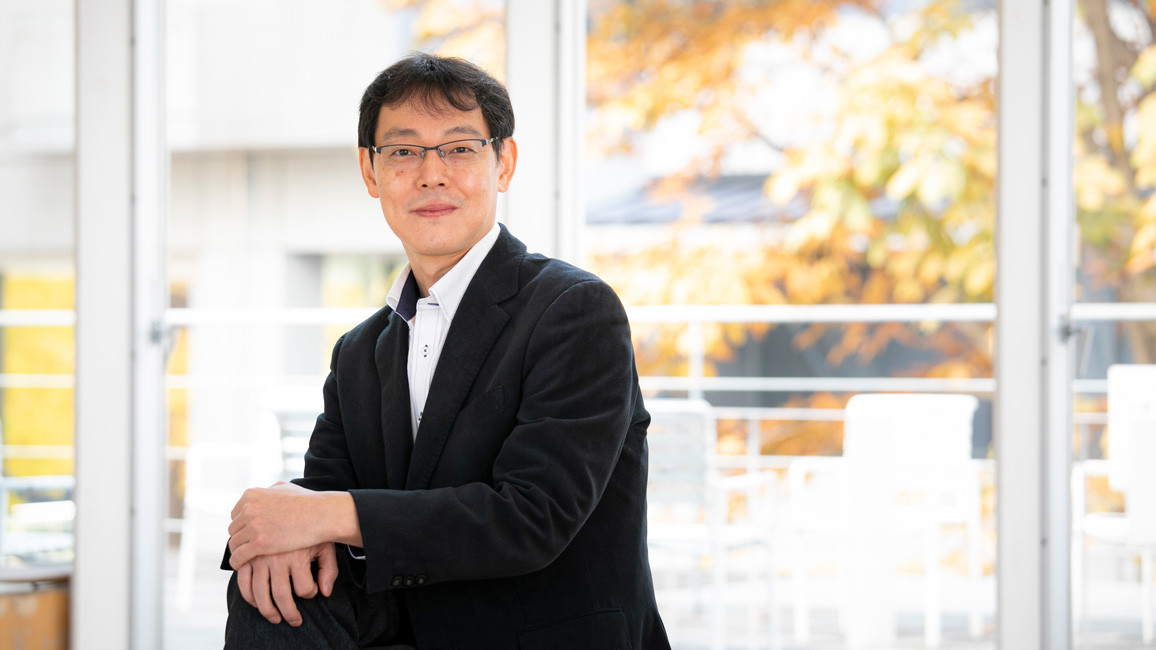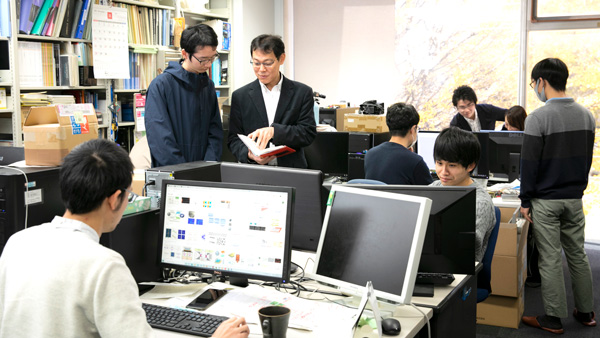- HOME
- Research at RCAST
- Visit to Laboratories
- Iwamoto Laboratory
Iwamoto Laboratory

We want to give people the ability to handle everything
from design to manufacturing with their own hands
A “photonic crystal“ is an artificial optical material with a periodic structure that has approximately the same scale as the wavelength of light. In recent years, such crystals have attracted attention as a way to achieve new possibilities in the field of optical technology. At the Iwamoto Laboratory, we pursue goals that include the use of photonic crystals to research technology capable of dramatically improving optical information transmission. We also actively engage in collaborative research with multiple groups that include other university laboratories.
In pursuit of technology to achieve major evolutions in photonics
Nowadays, photonics—a technology that uses light—is a pervasive and widespread part of our daily lives. In recent years, “photonic crystals” have attracted attention as a way to achieve new possibilities in the field of photonics. Our laboratory uses photonic nanostructures—including photonic crystals—to conduct research aimed at the development of technology for facilitating the evolution of optical telecommunications and similar fields.
We are especially focused on the field of “topological photonics.” Topology is a mathematical field concerned with the shapes of things, and—by taking advantage of this approach—it is possible to give photonic crystals new functions. By doing this, we expect to find a way to dramatically miniaturize optical circuits. Similarly to the way the miniaturization of electronic circuits changed the world, the miniaturization of optical circuits could have a profound effect on society.
At the same time, our laboratory also conducts research outside the field of topological photonics, including research related to quantum information devices that uses semiconductors and diamonds. Although these fields are similar in that they all use photonic nanostructures, the members engaged in each field generally work on research topics that they personally want to pursue.
A high school class as the entrance to the world of physics
I first started researching light while enrolled in the Department of Applied Physics of the Faculty of Engineering, and I later went on to finish the doctoral program and start working at the Institute of Industrial Science. I have been researching photonic crystals ever since. However, although I have been working as a researcher since then, I actually didn't think I would be a researcher up until around when I started the master's program.
My parents worked in the construction industry, so, from the time I was a kid, I sort of thought I would end up inheriting the family business. However, I had a change of heart as a result of a fascinating high school physics class. We never used a textbook in that class. Instead, all we ever did was experiments. First, we would predict the results, and then we would do the experiment and discuss what happened. I found that incredibly interesting, and that experience sparked my interest in physics and motivated my decision to study physics at the university.
However, I tend to change my mind, and—while I was enrolled in the master's program—I was also studying to obtain certification as an actuary, and it took a while for my path to become clear. But then I achieved some interesting results during my master's degree research, and my desire to delve into that research a bit more caused me to advance to the doctoral program, which ultimately got me to where I am today. I was never really guided by a clear goal. Instead, I just kept doing whatever seemed interesting at any given time, which eventually got me here.
There is value in doing things yourself and agonizing over the situation
The main strength of our laboratory is its environment, which enables you to handle the entire process yourself, including everything from design and calculations to the actual manufacturing and even the related evaluation. Our policy is to enable every one of our students to experience the entire process themselves. When you try to make something yourself, things don't usually go as expected. That naturally causes you to think, which makes a lot of things clear. I believe this process is important for research. In other words, you come up with an idea, and then you agonize over it as you try to make it a reality. This is not at all easy, and it naturally takes time, but having such experiences during your time as a student is sure to prove useful in the future.
Getting a doctoral degree is not easy. In a sense, it is necessary to make something yourself, so there is no way to make it to the end without both the will and the passion. That's why it's important to like your research and to be able to immerse yourself in it. At the same time, research alone is never enough. That's why I want our students to maintain an interest in a wide variety of things even as they devote themselves to their research. I will also personally do everything in my power to ensure that everyone can advance their research based on this approach.
In terms of the path after graduation, many graduates go on to manufacturers, but there are people who become researchers at university or national research institutes as well. In addition, some people advance to fields other than research and development, such as consulting. I personally believe that the existence of various career paths is a good thing, so I would like to support graduates who are interested in completely different options after earning a degree here. Regardless of their individual paths, students who earn their doctoral degrees after struggling through our program tend to do well in their fields.




